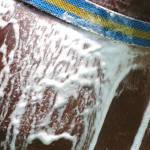Watery or Lathered: Differences in Horse Sweat

If you’ve spent time riding or driving horses, especially in heat and humidity, you know well the smell and feel of horse sweat. You may have wondered why sweat appears thin and watery sometimes, and thick and foamy other times.
In addition to electrolytes, horse sweat contains “latherin,” a detergent-like protein that helps move sweat from the skin to the surface of the coat. Once the coat gets damp and remains so, there is more opportunity for evaporative cooling. Latherin causes foaming of sweat in places of contact, usually where tack rubs against the coat or where two body parts rub together, such as between the inner thighs.
“The factors influencing the production of latherin in horses are unknown,” said Peter Huntington, B.V.Sc., M.A.C.V.Sc., director of nutrition at Kentucky Equine Research in Australia. “Popular opinions include lack of fitness and an excess of protein in the diet, but a definitive answer remains elusive. Horses, humans, and a species of monkeys are the only mammals known to sweat profusely to lose heat, though the compositions of their sweat varies significantly—humans have low-electrolyte, high-protein sweat, whereas horses have low-protein, high-electrolyte sweat.”
To keep skin and hair in best condition, all sweat should be removed from the coat as often as possible. In warm months, thoroughly rinsing the horse helps with this while also serving to help reduce body temperature following exercise. Careful attention should be paid to areas where contact with tack occurs, including out-of-the-way places such as between the front legs, along the girth-line, and under the tail, especially if a crupper is used. If horses are allowed to dry following exercise without being rinsed, they should be thoroughly curried and brushed to remove dried sweat. Many horsemen believe that sweating is beneficial for coat health but accumulation of dried sweat, even if only for a few days, is damaging to hair.
Horses that sweat often should be fed a broad-spectrum electrolyte, one that provides a full complement of electrolytes. A well-formulated electrolyte will feature sodium, chloride, and potassium, and may also contain magnesium and calcium. Electrolytes that feature sugar, sometimes listed as dextrose, as a primary ingredient should not be used, as these products often do not contain sufficient minerals to be useful, though they’re often palatable to horses. (Horses love sugar!)
Advances in electrolyte know-how have positioned some electrolyte products in the forefront. Restore SR, a commercial electrolyte developed by Kentucky Equine Research (KER), includes a slow-release mechanism that allows sodium to be absorbed gradually from the intestinal tract, thereby making it available to the horse over an extended period.
Restore SR is available in the U.S. and other markets. In Australia, look for Restore, Restore Paste, Endura-Max, and Endura-Max Paste.
For horses routinely given furosemide as part of a training or competition regime, Race Recovery provides targeted electrolyte supplementation for intensely worked equine athletes, supporting a quick rebound from hard work.








